
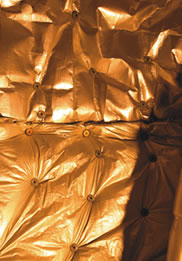
Cargo compartments on Boeing passenger and freighter airplanes incorporate comprehensive fire protection that includes fire detection and suppression systems.
Boeing designs cargo compartments to prevent fire and to provide passive and active protection systems should a fire occur.
This article is the second in a series exploring the implementation of fire protection on transport category airplanes.
Fire protection is given one of the highest considerations at Boeing in airplane design, testing, and certification. In designing an airplane’s fire protection features, Boeing uses the principles of prevention, separation, isolation, and control.
Prevention is the first order of the day, as it is better to prevent a fire than to have to contend with one in flight. The principles also involve separating the three essentials for creating a fire (i.e., fuel, ignition source, and oxygen), isolating potential fires from spreading to other parts of the airplane, and controlling a fire should one occur.
To effect this prevention, separation, isolation, and control, Boeing uses both passive and active features. Passive features include the use of noncombustible or self-extinguishing materials; separation by routing, compartmentalization, isolation, ventilation, and drainage; and bonding and grounding. Active features include fire and overheat detection systems, fire-suppression systems, temperature sensing, air shut-off means, and automatic shutdown of nonflight critical systems. Fire protection systems on Boeing airplanes meet all aviation regulatory requirements as well as internal Boeing design requirements.
This article describes how Boeing designs fire protection into the cargo compartments of passenger and freighter airplanes.
Cargo compartment classifications
The Federal Aviation Regulations classify cargo compartments into four categories:
Class A. The presence of a fire would be easily discovered by a crewmember while at his or her station and each part of the compartment is easily accessible in flight.
Class B. There is a separate approved smoke detector or fire detector system to give warning at the pilot or flight engineer station. There is sufficient access in flight to enable a crewmember to effectively reach any part of the compartment with the contents of a hand fire extinguisher. When access provisions are being used, no hazardous quantity of smoke, flames, or suppression agent can enter any compartment occupied by the crew or passengers. There are means to control ventilation and drafts within the compartment.
Class C. There is a separate approved smoke detector or fire detector system to give warning at the pilot or flight engineer station. There is an approved built-in fire extinguishing or suppression system controllable from the flight deck. There are means to exclude hazardous quantities of smoke, flames, or suppression agent from any compartment occupied by the crew or passengers. There are means to control ventilation and drafts within the compartment so that the suppression agent used can control any fire that may start within the compartment (see fig. 1).
Figure 1: Class C lower cargo compartment
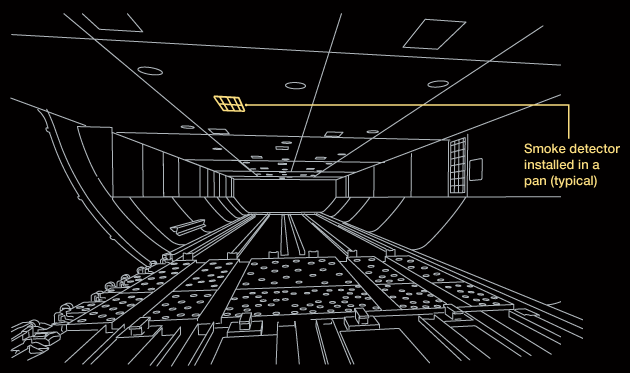
Class E (allowed only on airplanes used strictly for carrying cargo). There is a separate approved smoke or fire detector system to give warning at the pilot or flight engineer station. There are means to shut off the ventilating airflow to, or within, the compartment, and the controls for these means are accessible to the flight crew in the crew compartment. There are means to exclude hazardous quantities of smoke, flames, or noxious gasses from the flight crew compartment. The required crew emergency exits are accessible under any cargo loading condition (see fig. 2).
Figure 2: Class E main deck cargo compartment
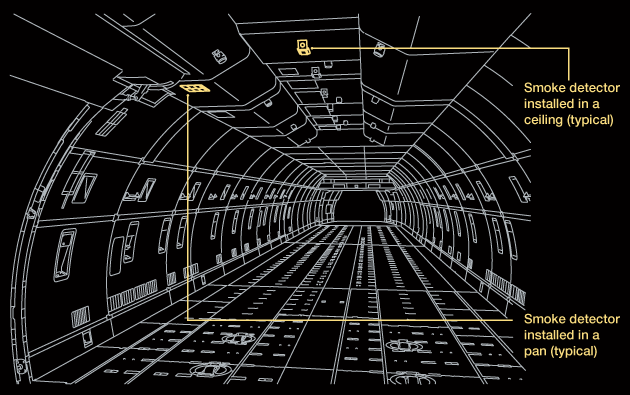
Additional requirements for cargo compartment fire protection
In addition, the following are required by the regulations:
Liners. The liner must be separate from (but may be attached to) the airplane structure (see fig. 3). Ceiling and sidewall liner panels of Class C compartments must meet fire test requirements.
Figure 3: Fire protection in a typical cargo compartment
This main deck cargo compartment illustrates two types of fire protection: liners on the sidewalls and smoke detectors running overhead.
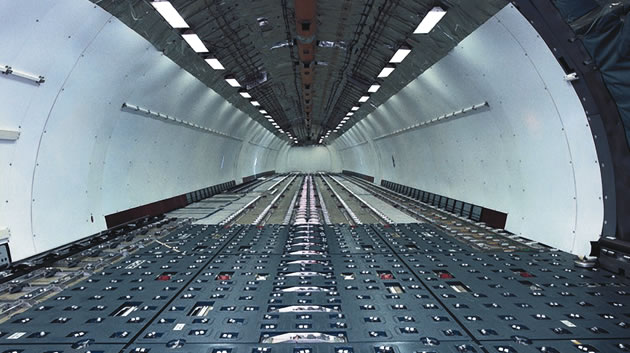
Construction materials. All materials used in the construction of the cargo compartment besides the liners must meet applicable test criteria that include fire tests as required.
Controls. No cargo compartment may contain any controls, lines (wires, tubing, cables), equipment, or accessories whose damage or failure would affect safe operation, unless those items are protected so that they cannot be damaged by the movement of cargo in the compartment and their breakage or failure will not create a fire hazard.
Cargo/baggage restraint. There must be means to prevent cargo or baggage from interfering with the functioning of the fire protective features of the compartment.
Heat sources. Sources of heat within the compartment (i.e., from lights, control panels) must be shielded and insulated to prevent igniting the cargo or baggage.
Wiring. Cargo compartment electrical wiring interconnection system components must meet installation requirements, such as wire separation, and component qualification tests.
Tests. Certification ground and flight tests must be conducted to demonstrate various requirements. These include:
- In-flight access to cargo compartments for Class A, B, and E cargo compartments.
- The prevention of hazardous quantities of smoke or suppression agent from entering into compartments occupied by the crew or passengers.
- Demonstration of the smoke detection system is performed to show compliance to all requirements, including flight testing to show that the system performs its intended function at all foreseeable operating conditions.
- Concentration measurements for the suppression agent in Class C compartments.
During these flight tests, it must also be shown that no inadvertent operation of smoke or fire detectors in any compartment would occur as a result of fire contained in any other compartment, either during or after extinguishment. (Although fire extinguishing is the term used by the regulatory authorities, the more realistic term is fire suppression. A fire in a cargo compartment is required to be suppressed long enough for an airplane to land and evacuate passengers and crew safely. Both terms are used interchangeably in this article.)
Cargo compartment liners
Liners are a passive fire protection feature. The primary purpose of a cargo liner is to prevent a fire originating in a cargo compartment from spreading to other parts of the airplane before it can be brought under control by the fire suppression system.
In Class C cargo compartments — which include the lower cargo compartments of all passenger airplanes and the lower cargo compartments for most freighters — the cargo compartment sidewall and ceiling liner panel installations are fire tested to determine flame penetration resistance. Test requirements specify that a minimum of three specimens must be tested; there must be no flame penetration of any specimen within five minutes after application of the 1,700 degrees F (927 degrees C) flame source; and for ceiling liners, the peak temperature measured at four inches above the upper surface of the horizontal test panel must not exceed 400 degrees F (202.4 degrees C). All other materials must be self-extinguishing.
Many Boeing-certified freighter airplanes’ main deck Class E cargo compartments also incorporate cargo liners made from the same material that meets Class C compartment liner requirements.
Smoke detection
Class B, C, and E cargo compartments have smoke detection systems that provide active fire protection. These systems are designed to provide an aural and visual indication to the flight crew in the early, smoldering phase of a fire prior to it breaking out into a large fire. In older model airplanes, the time to detect a fire was not quantified by the regulators. Smoke detection systems of that era typically met a five-minute detection time. Using newer technology, smoke detection systems can provide an indication in a shorter time. Based on a simulated smoke source representing a smoldering fire, all newer airplanes can detect a fire within one minute. In all cases, the smoke detection systems can detect a fire at a temperature significantly below that at which the structural integrity of the airplane could be adversely affected.
Almost all cargo compartment smoke detectors are based on photoelectric sensing. Smoke particles interfere with a light beam inside the detector, causing the light to scatter onto a photosensitive diode, which increases the photodiode’s current output and generates an alarm. A smoke detector can be described by how the smoke enters the sensing chamber: draw-through or open-area type (see fig. 4).
Figure 4: Types of smoke detectors
A smoke detector can be described by how the smoke enters the sensing chamber.
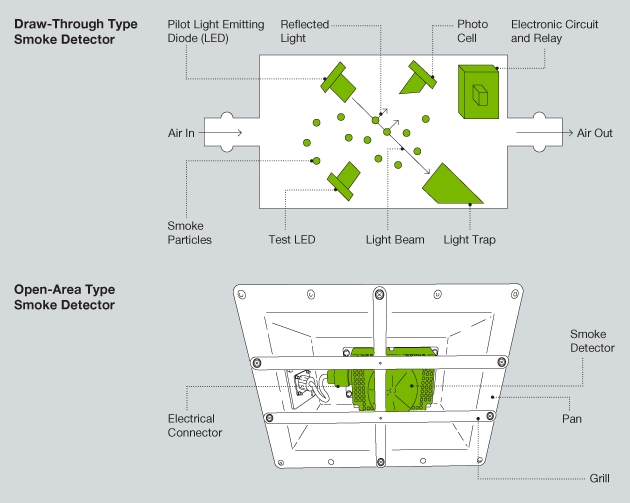
Draw-through type detectors, also known as active smoke detectors, continuously monitor a sample of air drawn from the cargo compartment for the presence of smoke — an indication of a fire condition. A draw-through detection system consists of a distributed network of sampling tubes (see fig. 5) that bring air sampled through various ports located in the cargo compartment ceiling to the smoke detectors located outside the cargo compartment. The air is also exhausted outside the compartment.
Figure 5: Draw-through cargo smoke detection system
Many Boeing airplanes utilize draw-through smoke detectors in the cargo compartment smoke detection systems.
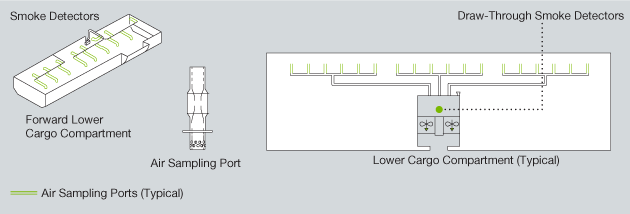
Open-area type detectors, also known as passive smoke detectors, are installed inside the compartment, usually in the ceiling, and directly exposed to the smoke (see figs. 1 and 2).
In addition, there are means to allow the crew to perform in-flight system testing of each fire detector circuit to ensure proper function. The effectiveness of the detection system must be shown for all approved operating configurations and conditions.
The cargo compartments of all Boeing airplanes are equipped with multiple smoke detectors. For example, the MD-11 freighter main deck cargo compartment has 18 area smoke detectors; 14 distributed axially along the compartment overhead centerline and four located in the forward area of the cargo compartment (see fig. 6). A smoke signal from any smoke detector will trigger a fire alarm at the flight deck. This is a “single loop” system because any single detector can set off the fire alarm.
Figure 6: Cargo compartment smoke detectors
All cargo compartments have multiple smoke detectors. This main deck cargo compartment has 18 smoke detectors.
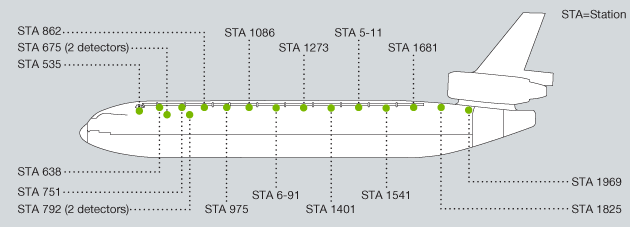
The smoke detection systems in each cargo compartment can also be designed in a dual-loop (two single-loops) configuration. The smoke detectors are organized with one or more detectors associated with each single-loop. In a dual-loop system, two separate smoke signals are required to generate a fire alarm at the flight deck. Most Boeing airplanes use a dual-loop configuration for cargo smoke detection systems. For both dual-loop and single-loop systems, there is guidance provided through the master minimum equipment list to allow dispatch if a smoke detector is inoperative.
When smoke is detected in the cargo compartment, visual and aural warnings are provided at the flight deck (see fig. 7). Two red master warning lights are located on the glare-shield, one in front of the pilot and one in front of the first officer. In addition, on airplanes with engine indicating and crew alerting systems (EICAS), the message FIRE CARGO FWD or FIRE CARGO AFT is displayed on the upper EICAS display located on the main panel to identify the affected lower compartment. On all airplanes and on older airplanes without the EICAS system, individual red lights for the cargo compartment with the fire will light (e.g., FWD CARGO FIRE or AFT CARGO FIRE).
Figure 7: Typical flight deck indications and control
When smoke is detected in a cargo compartment, visual and aural warning indications are provided at the flight deck, which also has controls for the cargo compartment fire suppression system.
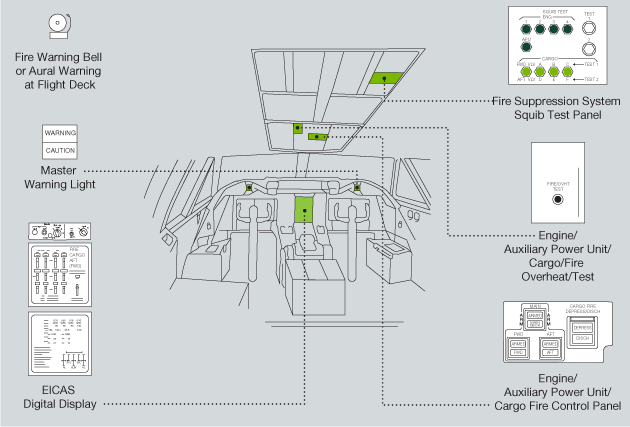
For the main deck compartment on the Boeing 747-400F, the message FIRE MN DK FWD, FIRE MN DK MID, or FIRE MN DK AFT will be displayed on the EICAS to identify the affected area within the main deck compartment. The EICAS warning message FIRE MAIN DECK is displayed if smoke is detected in more than one zone of the main deck cargo compartment.
A fire bell or aural warning will sound in conjunction with the visual fire warning, lights, and messages.
Fire suppression
The first step in controlling and suppressing a fire (after turning off the aural warning) is shutting down the airflow to the cargo compartment. All ventilated cargo compartments have a means for shutting off the airflow from the flight deck. Following airflow shutdown, Boeing-designed Class C cargo compartment fire suppression systems provide minimum Halon 1301 concentration coverage for one hour or more, depending on the airplane model, sufficient to suppress the fire until the airplane lands at the nearest suitable airport. The flight crew commands the discharge of the cargo fire suppression system from the flight deck (see Engine/Auxiliary Power Unit/Cargo Fire Control Panel in fig. 7). This initiates the discharge of halon from fire suppression bottles, which are generally located next to the cargo compartment. Additional fire suppression capability is designed into the airplane as required for Extended Operations and is dependent on airline customer option configuration.
Typically, cargo fire suppression systems have an initial high-rate knockdown discharge, followed by a low-rate metered discharge of Halon 1301, designed to keep the fire suppressed for continued safe flight and landing at the nearest suitable airport.
Halon can be discharged into the forward or aft cargo compartment. The probability of a cargo fire in any compartment is very low, and the likelihood of two simultaneous fires in two cargo compartments is even lower. Because of this, it is not required to have separate halon bottles for each compartment. One set of bottles provides suppression capability to either cargo compartment.
In all models, once a fire is detected and the halon discharged, minimum halon concentrations are required for the remaining duration of flight. Compliance to these requirements is demonstrated by measuring suppression agent concentration at key locations in the compartment during a certification flight test.
The initial knockdown fire suppression systems installed in all Boeing airplane cargo compartments consist of Halon 1301 bottles discharged through a distribution tubing system to discharge nozzles in the respective cargo compartment ceiling. This initial discharge knocks down the flames and suppresses a fire with a minimum of 5 percent Halon 1301 concentration by volume. The system is sized as a function of compartment volume, temperature, and cabin altitude and typically takes one to two minutes to reach maximum concentrations.
A second discharge, a metered system with a flow regulator (see fig. 8), is either discharged at the same time as the initial knockdown or after a specified time delay and provides a steady-state halon flow rate to maintain compartment halon concentrations above 3 percent for a specified duration. The required metered flow is a function of compartment leakage. The higher the compartment leakage rate, the higher the halon flow rate must be to compensate. Cargo compartments are designed to minimize compartment leakage during a fire to maximize halon retention and to reduce smoke penetration effects.
Figure 8: Typical metered fire extinguishing system with a flow regulator
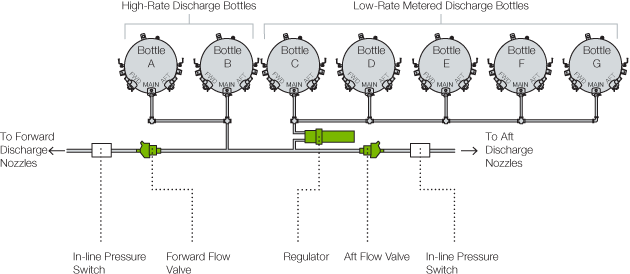
An alternate method for maintaining the minimum required halon concentration is the high-rate discharge fire suppression system. As the concentration of agent from the initial knockdown decays and approaches 3 percent, a subsequent bottle is discharged; the concentration increases and again begins to decay. Depending on system design, additional bottles may be discharged to maintain concentration levels above 3 percent until the airplane has landed safely and the passengers and crew evacuated (see fig. 9). An airplane timer is turned on when the first discharge occurs and subsequent discharges are made manually by the flight crew. The time delay for discharging the additional high-rate bottles is defined in the airplane flight manual and is also usually incorporated into the alert messaging logic.
Figure 9: Cargo fire suppression performance by type of system
Cargo fire suppression systems typically have an initial knockdown concentration discharge of Halon 1301 followed by an additional high-rate discharge (left) or a low-rate metered discharge (right).
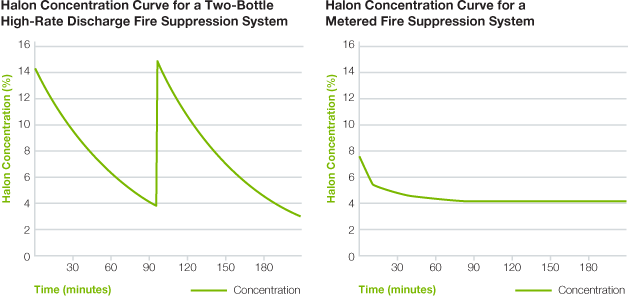
Firefighting in a Class E cargo compartment is accomplished by shutting down the airflow to the compartment, depressurizing the airplane, and (depending on airplane) descending to just below 25,000 feet as conditions permit. If it is not possible to immediately land at a suitable airport, the depressurized airplane is maintained at approximately 25,000 feet to minimize the oxygen available to the fire. Supplemental oxygen is provided to the flight crew and any supernumeraries via oxygen masks when the cabin altitude exceeds 10,000 feet.
Controlling smoke penetration
Boeing uses a two-pronged approach to exclude hazardous quantities of smoke and noxious gases from entering the flight deck or other occupied compartments.
First, the flight deck and passenger compartments are maintained at a slightly higher pressure relative to adjacent compartments that may contain smoke or noxious gases during Class C or E compartment fire suppression.
In Class E compartments, one air-conditioning pack remains on a low-flow setting. This airflow provides air to the flight deck and exits via the electrical equipment cooling system and through air return paths into the forward lower cheek areas. In addition to acting as a pressure source, the fresh air entering the flight deck also serves to sweep away trace amounts of smoke that may enter the compartment. Smoke within the flight deck is self-clearing and hazardous accumulations are prevented.
Air pathways in and out of occupied areas, including the flight deck, are controlled to ensure that the pressure differential produced is effective in preventing smoke migration into the compartment. In addition, other methods are also used, such as sealing of bulkheads, e.g., rigid cargo barriers on freighters, to minimize smoke penetration.
Second, the individual cargo compartments have liners and barriers designed to minimize the amount of smoke leakage out of the compartment into occupied areas. On different airplanes, these compartment closeouts and seals take different forms, but the integrity of the liners and other smoke barriers is important in establishing and maintaining the fire protection capability of the airplane.
Component tests and certification tests. All components specified for the fire protection, smoke detection, and fire suppression systems are qualification tested to the requirements specified by Boeing. Certification ground and flight tests are conducted on the smoke detection and fire suppression systems. In addition, smoke penetration tests are also conducted to comply with Boeing and regulatory requirements.
Summary
Boeing designs cargo compartments in passenger and freighter airplanes to prevent a fire and to provide passive and active fire protection systems to control a fire should one occur. Boeing gives the highest considerations to the safety of passengers and crew.

